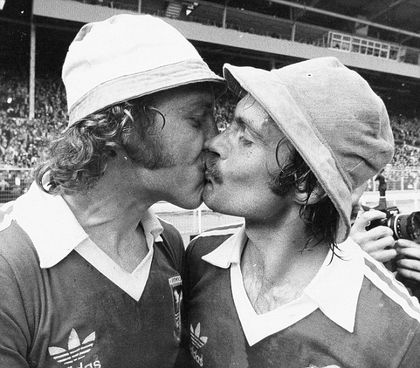I'm not as suddenly pessimistic about the All Blacks' chances of winning the Rugby World Cup as some folk, but I can confidently make this prediction: whoever wins, there will be hugs, hugs and even more hugs.
Rugby clearly did not invent the sporting hug, but its modern ubiquity seems more notable in light of New Zealand rugby's long (proud, even) tradition of emotional suppression. By that tradition, an All Black who scored a crucial try was expected to pick himself up without celebration, toss the ball to the kicker and trot back towards halfway, perhaps collecting a couple of handshakes on the way.
This was actively promoted as a virtue. When I was a kid, the Burnside Rugby Club newsletter would refer to football as "the kiss and cuddle code", a source of the kind of unwarranted emotion and intimacy from which parents ought to keep their sons well clear.
Look at this reel of great All Black moments of the 1960s. No matter how brilliant the try, the moment it's awarded, the team turns and jogs back to half way. Half the time the scorer isn't even congratulated:
By the 197os, half-hearted expressions of joy started to appear. Watch as a few players sheepishly raise a hand after Sid Going burrows over for a try against the Springboks at the one-minute mark:
By the 1987 World Cup final, we are clearly in a new era. After David Kirk scores at the eight minute mark, Buck Shelford helps him to his feet and administers a couple of congratulatory cuffs to the back of the halfback's head as they track back. And then, from 11 minutes, there are actual embraces in victory. Nothing like you'd get now, but there are men definitely touching each other:
So let's fast-forward to the aftermath of the 2011 final, when this happened:
Clearly, much of this can be put down changes in the way men relate to each other off the field, but I wonder if some degree of permission for that has flowed the other way too.
I first recall pondering this in the 1990s (no, really, I ponder lots of things) and wondered then if the introduction of entactogenic drugs to the practice of partying had changed popular culture. Suddenly, it was okay to not only hug your mate, but even tell him you loved him.
Since then, we've seen the rise of hip hop's thumbs-up-handshake-to-chest-bump version of the hug offering a kind of limited, but sincere, intimacy. But mostly, it's the full man-hug, all the time.
I'm told by my mother that I never shied from a hug as a child, but even so, I hug a lot more than I used to. When my best mate comes around for a beer, which is a not infrequent occurrence, we always part with a hug. Sometimes we meet with one too. The signal is always the same: the throwing open of the arms, the opening of the chest. It's good.
This poses some obvious problems for people who are generally uncomfortable with hugging or being hugged. One or two of those people are dear friends and I try and remember the boundaries when I greet them. And there are also clearly issues for women who get unwelcome hugs from men whose intentions they distrust. The hug, like the ubiquitous and not always welcome cheek-kiss (something else we never used to do in New Zealand) does provide an avenue for the creepers.
But those caveats aside, and whether we changed the game or the game changed us, when the whistle sounds and I see men trained to brutally collide with each other exchange an embrace, I do think it's better than it used to be.
